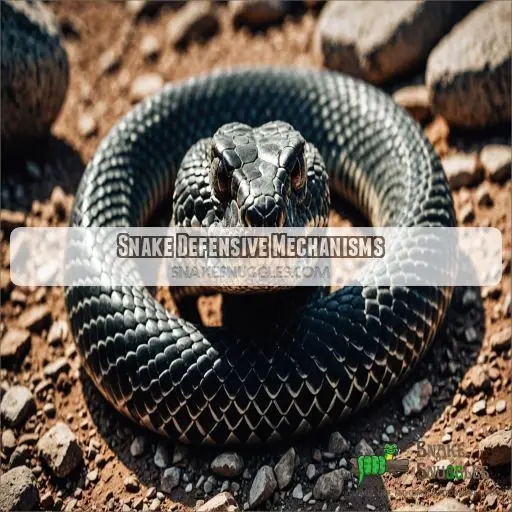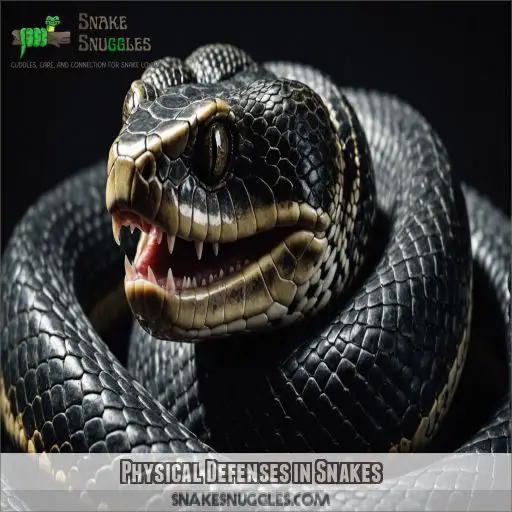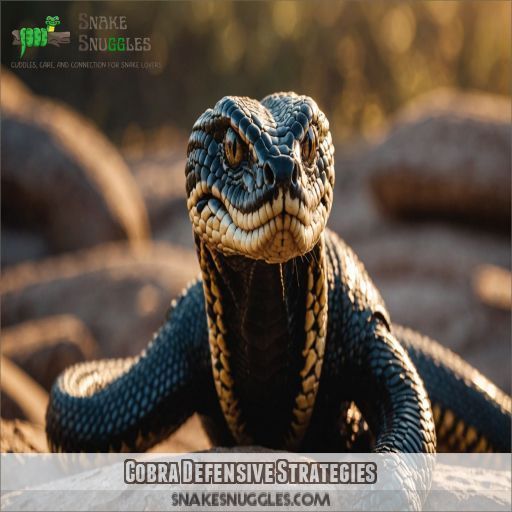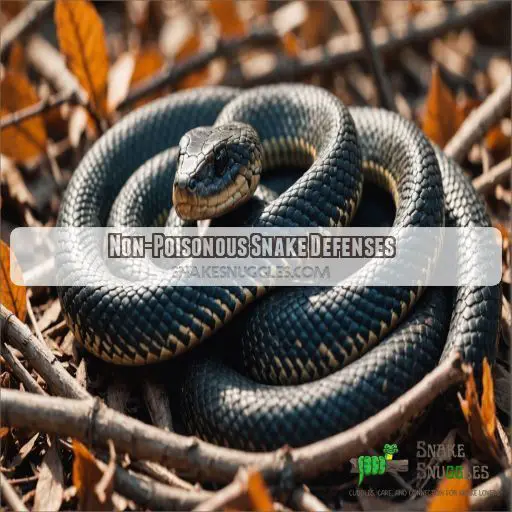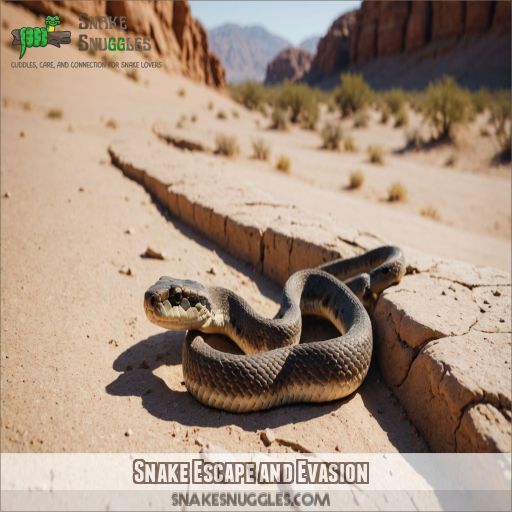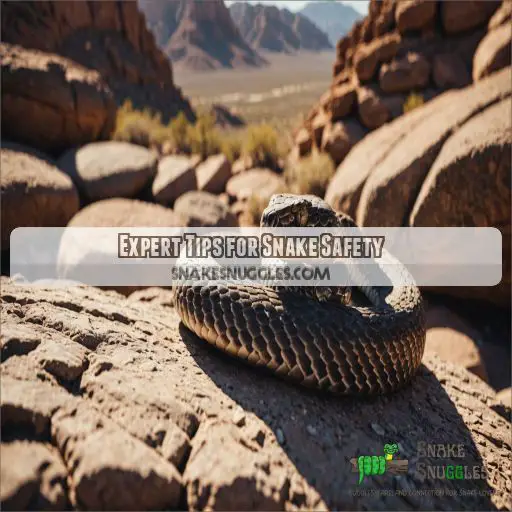This site is supported by our readers. We may earn a commission, at no cost to you, if you purchase through links.
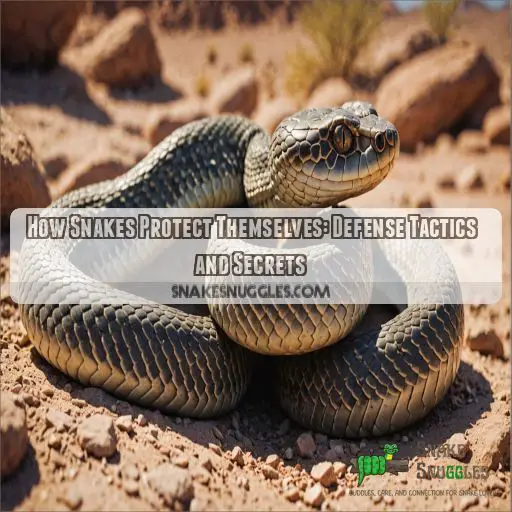 Snakes are like nature’s stealthy ninjas, using a variety of clever tactics to stay safe.
Snakes are like nature’s stealthy ninjas, using a variety of clever tactics to stay safe.
They blend in with their surroundings using camouflage—imagine a chameleon’s color-changing cousin—or flaunt vibrant colors to say, "Hey, I’m dangerous!"
Some cheeky serpents mimic nastier counterparts or even play dead, hoping predators will pass them by.
When cornered, they might put on a theatrical display, hissing and coiling to seem bigger and more threatening.
Preferring to bite as a last resort, they rely on speed and agility to escape.
Want to uncover more about how these fascinating creatures protect themselves? Read on!
Table Of Contents
- Key Takeaways
- Snake Defensive Mechanisms
- Physical Defenses in Snakes
- Cobra Defensive Strategies
- Non-Poisonous Snake Defenses
- Snake Escape and Evasion
- Expert Tips for Snake Safety
- Frequently Asked Questions (FAQs)
- How do snakes escape from enemies?
- How are snakes protected?
- What body parts of a snake are used for protection?
- How do non-poisonous snakes defend themselves?
- How do snakes detect approaching predators?
- Do all snakes have the ability to swim?
- How do snakes communicate danger to others?
- What role do temperature changes play in snake defense?
- Can snakes regenerate parts of their body for defense?
- Conclusion
Key Takeaways
- Snakes are like nature’s undercover agents, blending into their surroundings with impressive camouflage, from cryptic coloration to disruptive patterns. It’s like they’re wearing the ultimate invisibility cloak, making it tough for predators to spot them.
- Watch how snakes use mimicry and deception to fool predators, acting like their venomous relatives. Imagine them putting on a disguise like the secret superhero of the animal world – complete with their own dramatic performances.
- When push comes to shove, snakes have an arsenal of physical defenses. From impressive hissing and posturing like a coiled spring ready to launch, to using their venomous fangs as nature’s hypodermic needles – they know how to back off intruders.
- Non-venomous snakes are no shrinking violets; they might play dead or release a stinky perfume that rivals any middle school gym locker, proving they’ve got more tricks up their sleeves than Houdini!
Snake Defensive Mechanisms
Ever wondered how snakes manage to avoid becoming dinner? You’ll be surprised to learn they’ve got a few tricks up their scaly sleeves, from perfect camouflage to playing the ultimate game of charades.
Camouflage and Concealment
In nature’s game of hide and seek, snakes are masters of disguise. Through camouflage effectiveness, they match their environment. Here’s how:
- Cryptic Coloration: Sly and sneaky.
- Snake Patterns: Banded, speckled, and striped.
- Environment Matching: A perfect chameleon.
- Camouflage Evolution: Nature’s hide-and-seek champion.
Warning Colors and Aposematic Coloration
Snakes, like the pygmy rattlesnake and timber rattlesnake, flaunt warning colors as an evolutionary advantage. These vibrant hues serve as a neon "Keep Out" sign, aiding predator recognition. Such behavioral adaptations showcase their savvy in predator deterrence, avoiding snake myths.
Mimicry and Deception
In South Carolina, snakes aren’t just about flashy warning colors. They master mimicry, imitating venomous species like talented actors to fool predators. Watch a harmless snake play tough, mimicking sounds or postures—like wearing a secret superhero disguise.
Autotomy and Sacrifice
Ever wondered about Autotomy and Sacrifice in snakes? Although snakes can’t drop their tails like lizards, understanding lizard defense can be illuminating:
- Tail loss: It’s like losing your roller skate mid-race.
- Regeneration: A costly yet life-saving feat.
- Amputation: The ultimate sacrifice benefit.
- Understanding: Helps guide snake bite prevention.
Bluffing and Threat Displays
While some lizards sacrifice their tails, snakes often rely on bluffing. Picture a cobra’s hood display—it’s as if the snake is saying, "I’m bigger than I look!" Such snake bluff tactics, like lizard threat postures, deter attackers beautifully.
Physical Defenses in Snakes
When threatened, snakes don’t mess around – they’ve got a formidable arsenal of physical defenses at the ready. From their venomous fangs and powerful jaws to their ability to coil up and strike, these slithery survivors know how to protect themselves. (Source)
Biting as a Last Resort
Snakes have ingenious survival tactics.
. When camouflage and other tactics fall short, they rely on biting as a last resort. Here’s your quick guide:
- Biting triggers: threats look larger than life.
- Bite defenses: survival mode on.
- Avoid bites: stay calm.
- Bite impact: damage control, pronto.
Venomous Fangs and Powerful Jaws
You’ve heard of snakes’ venomous fangs, right Venomous Fang Delivery.
? They’re nature’s syringes, evolved for precise venom delivery. With advanced jaw mechanics, snakes handle prey efficiently. While their bite force isn’t bone-crushing, it’s effective for subduing prey. Perfect for a snake’s dinner party—if you’re not the guest!
Use of Body Parts for Protection
In addition to their venomous fangs, snakes have other body parts they can use for protection. Their scales provide armor-like defense, while their rattles warn predators to back off. Some snakes even use their tails to lure in prey, or flatten their necks and bob their heads to appear more threatening.
Coiling and Posturing
Coiling up protects snakes like a living blanket, safeguarding essential organs and preparing for strike readiness. This muscle tension and positioning turn them into a spring-loaded surprise! Coupled with camouflage techniques and auditory deterrents, their elaborate posturing convinces predators that biting this bundle isn’t wise.
Cobra Defensive Strategies
When you think of cobras, imagine nature’s ultimate bodyguards, packing an arsenal of tricks like a master magician. From blending in with their surroundings and flaring their iconic hoods, to delivering a bite with enough venom to make predators reconsider what’s for dinner, cobras are truly mesmerizing.
Hiding and Crypsis Tactics
Let’s talk about cobra camouflage. These sneaky serpents are masters of blending in, avoiding attention like a pro. They use:
- Environmental camouflage to match their surroundings.
- Disruptive patterns to confuse predators.
- Substrate mimicry for ultimate stealth planning.
Nature’s little magicians!
Cobra Hood Mechanisms
When threatened, how do cobras defend themselves? By raising up to a third of their length off the ground and spreading their ribs, cobras create an impressive hood display that warns predators to keep their distance. This evolutionary adaptation helps cobras deter attacks through sheer intimidation.
Venomous Bite Defenses
Cobras pack a serious punch with their venomous bite defenses. These fascinating creatures possess different venom types specifically for prey immobilization and predator deterrence. Understanding venom dose, bite location helps in antivenom use.
. So, if you ever encounter one, remember—ain’t nobody got time for a snake bite!
Spitting Venom Capabilities
Some cobras possess an astounding capability—spitting venom. Imagine aiming a garden hose; their venom projection accuracy is just as impressive! This technique, with venom spitting range up to eight feet, demonstrates evolutionary origins. It’s a surprisingly effective defense, deterring predators without close encounters.
Non-Poisonous Snake Defenses
You’re about to learn how even non-venomous snakes are tough guys of the wild, cleverly using colors, coils, and occasionally stinky tactics to ward off trouble. Don’t underestimate them—even these “non-poisonous” slitherers can teach you a thing or two about survival with their nifty mimicry skills and Houdini-like escapes.
Use of Patterns and Colors
Imagine spotting a snake’s vivid patterns—stripes or spots could be just the ticket for sneaky critters. They use disruptive camouflage for substrate matching, blending seamlessly! Some employ color polymorphism, mimicking venomous relatives with automimicry, leaving onlookers confused and convinced they’ve seen a serpent superhero!
Balling and Coiling
When threatened, non-venomous snakes may ball up or coil their bodies to protect their vulnerable head and neck. This defensive posture both deters predators and helps the snake regulate its body temperature. The tight coil acts as a shield against would-be attackers.
Odors and Smells
While balling and coiling might seem theatrical, some snakes use smell-based deterrence as their secret weapon. When threatened, they release defensive odors, often described as stinky perfumes. These chemical smell signals confuse predators, creating a sort of odor camouflage. Mind the stench!
Mimicry of Venomous Snakes
Now and then, you might spot a non-venomous snake pulling off a clever Batesian mimicry trick. It’s like playing dress-up, fooling predators into thinking they’re venomous. Consider these benefits:
- Predator confusion buys time.
- Evolutionary advantages grow stronger.
- Ecological impact stabilizes ecosystems.
Snake Escape and Evasion
Did you know that snakes are expert escape artists, using their speed, agility, and wits to evade danger? Like the ultimate game of hide-and-seek, they skillfully use their tail, find clever hiding spots, and on occasion, even play dead to trick unsuspecting predators.
Speed and Agility
When threatened, snakes can rapidly slither away, zigzagging at lightning speed to confuse and outmaneuver predators. Their agile movements and quick reflexes make them masters of evasion, allowing them to swiftly escape danger and reach safety. Stay alert and give snakes plenty of space to avoid provoking their defensive tactics.
Use of the Tail
Snakes use their tails for more than just balance. They’ve got clever tricks up their sleeves—or rather, their scales!
- Tail for Balance: Helps in swift escape.
- Tail Luring: Distracts predators.
- Tail Camouflage: Blends in with surroundings.
- Tail Rattling: Warns threats away.
- Defensive Tail Mocking: Imitates head strikes.
Hiding and Seeking Shelter
When danger lurks, some snakes dash off using their tails. In contrast, others excel at environmental camouflage, nestling under rocks or burrowing in soft soil for predator avoidance, temperature regulation, hunting strategies, and even illness recovery. It’s like their very own secret hideaway!
Playing Dead
Imagine you’re a snake actor starring in the "Save Your Skin Show." Playing dead, or using tonic immobility, is your Oscar-winning performance! Predators might think you’re expired, a less tasty choice, ensuring smooth escape. Master this survival strategy and avoid becoming someone’s lunch.
Expert Tips for Snake Safety
When you’re out and about, knowing a few snake safety tips can be as important as remembering sunscreen on a sunny day. By understanding snakes’ natural behavior, such as their snake hissing sounds, and staying calm, you’ll avoid unnecessary run-ins and keep your heart rate stable.
.
Knowing Your Snakes
Knowing your snakes is key to staying safe, as copperheads have distinctive hourglass-shaped crossbands.
. Learn to identify common species in your region – their colors, patterns, and behaviors. Understand which ones are venomous and how to avoid provoking them. This knowledge can make all the difference in a close encounter.
Taking Caution
Encountering snakes while hiking isn’t uncommon. Spotting one ahead? Give it space! Respect wildlife by observing from a distance. Study venomous identification beforehand; it’s a real lifesaver. Always carry first aid supplies. Remember, snake encounters are just nature’s way of staying awake during dull hikes!
Staying Calm
Facing a snake encounter might rattle your nerves, but staying calm is your secret weapon. Here’s how:
- Take deep breaths, calming your heart as if you’re meditating.
- Focus on managing fear with relaxing techniques.
- Respond calmly, like a snake whisperer.
Avoiding Provocation
Around snakes, playing it cool is key. Respect their space, and you’ll avoid surprises. Like avoiding a dance-off with a reluctant partner, leave them alone and admire from a distance. Heres a quick guide:
| Snake Behavior | Safe Handling | Respect Boundaries |
|---|---|---|
| Stay Observant | Move Slowly | Keep Distance |
| Look for Signals | Use Tools | Don’t Corner Them |
| Avoid Loud Noises | Wear Gloves | Allow Escape Routes |
| Walk the Path | Stay Calm | Avoid Touching |
| Night Caution | Guide with Care | Never Taunt Them |
Frequently Asked Questions (FAQs)
How do snakes escape from enemies?
When snakes need to hightail it from predators, they slither with impressive speed or vanish into hiding spots. They also rely on camouflage, making them hard to spot, like a chameleon blending with its surroundings.
How are snakes protected?
Snakes are masters of disguise, blending seamlessly into their surroundings like chameleons. When threatened, they puff up, hiss, and even strike – a dazzling display to ward off predators. Their secret weapons? Camouflage, venom, and a whole lot of attitude!
What body parts of a snake are used for protection?
A snakes protection arsenal includes its fangs for biting, its scales for camouflage, and its body for coiling or puffing up.
. Hissing serves as an audible warning, while its coloration can trick or deter predators .
How do non-poisonous snakes defend themselves?
Non-poisonous snakes, much like the ultimate "Houdini," rely on camouflage, mimicry, and quick escapes. They might play dead, hiss, or even vibrate their tails to mimic rattlesnakes, ensuring predators think twice before approaching (Source).
How do snakes detect approaching predators?
Imagine you’re a snake detective. You use your tongue to "taste" the air, picking up chemical clues. Your sensitive skin feels vibrations, while keen eyes spot movement. Just like Sherlock, you’re ready for any sneaky predator!
Do all snakes have the ability to swim?
Yes, all snakes can swim. Think of them as little reptilian lifeguards! While their skills vary, they all perform underwater ballet thanks to those slinky bodies, making them more than just fantastic land movers.
How do snakes communicate danger to others?
Picture a snake doing its best "stay away" dance—hissing loudly, flaring its ribcage into dramatic hoods, or flashing bright, warning colors to scream "danger ahead!" It’s a snake’s way of saying, "Trespassers will be snacked on!
What role do temperature changes play in snake defense?
Temperature changes greatly impact a snake’s defense mechanisms and behavior. Snakes rely on external heat to regulate their body, so shifts in temperature affect their ability to camouflage, strike, and even hibernate for protection.
Can snakes regenerate parts of their body for defense?
Just as lizards can ditch their tails to escape sticky situations, snakes don’t share this superhero power. They can’t regenerate lost parts like tails or body segments. Instead, they’ll rely on their cunning tactics to stay safe.
Conclusion
Snakes are expert escape artists, employing camouflage, mimicry, and impressive bluff tactics to evade threats.
They often use their speed or play dead instead of relying solely on their venomous bite.
Understanding their fascinating defense mechanisms can help you appreciate and safely coexist with these remarkable creatures.

